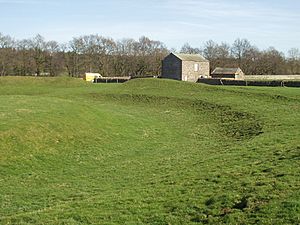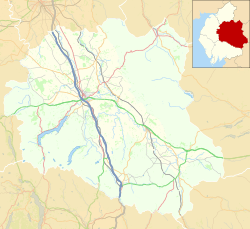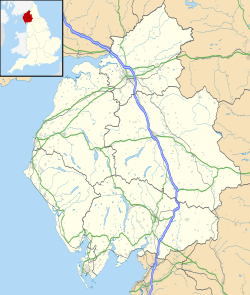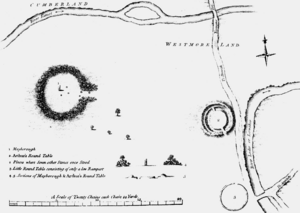King Arthur's Round Table facts for kids

King Arthur's Round Table
|
|
| Location | Eamont Bridge |
|---|---|
| Coordinates | 54°38′54″N 2°44′25″W / 54.6483°N 2.7403°W |
| Type | Henge |
| History | |
| Periods | Neolithic / Bronze Age |
| Site notes | |
| Ownership | English Heritage |
| Public access | Yes |
King Arthur's Round Table is a very old monument in England. It's a special type of ancient site called a henge. You can find it near the village of Eamont Bridge in Cumbria. This amazing place was built thousands of years ago, long before King Arthur's time! It's now looked after by English Heritage and you can visit it for free.
What is King Arthur's Round Table?
King Arthur's Round Table is a henge located in a field. It sits right next to the A6 road in the village of Eamont Bridge. This is just south of Penrith.
Some parts of the henge are now covered by modern roads and buildings. For example, the northern part is under the B5320 road and the Crown Hotel. The A6 road also takes up some of the eastern side.
This henge is part of a bigger ancient area. The much larger Mayburgh Henge is only 400 metres to the west. Also, traces of another henge, called Little Round Table, are 200 metres to the south. This shows that many henges were built close together here. It might have been a special ritual landscape, like the famous Stonehenge.
The henge itself is about 90 metres (around 295 feet) wide. The open space inside is about 50 metres (164 feet) across. The ditch around it can be up to 16 metres (52 feet) wide. There's also a flat area called a berm, which is 7 metres (23 feet) wide. The outer bank is about 13 metres (43 feet) wide.
Originally, there were likely two entrances to the henge. One was on the south-east side, and it's still there today. The other entrance, on the north-west, has been mostly destroyed by modern roads.
In the late 1700s or early 1800s, parts of the henge were changed. People thought about using it as a tea garden. Today, English Heritage takes care of the site, and everyone is welcome to visit.
Uncovering the Past: What Archaeologists Found
Archaeologists study old sites to learn about the past. Around 1664, a historian named William Dugdale drew sketches of King Arthur's Round Table. His drawings showed the two entrances. He also drew two tall standing stones near the north-west entrance.
However, when another expert, William Stukeley, visited in 1725, those stones were gone. In 1891, C. W. Dymond made a detailed record of what was left of the henge.
More recently, archaeologists did excavations (digs) at the site. R. G. Collingwood started digging in 1937. Gerhard Bersu continued the work in 1939. Their digs showed that the ditch had been cleaned out and reshaped in more modern times. The entrance was also made narrower.
Collingwood believed he found signs of old structures, like holes where wooden posts once stood. He also thought he found a "cremation trench" near the middle of the site. But Bersu disagreed with many of Collingwood's ideas. Bersu thought the postholes weren't important. He also found no clear proof of cremation.
Later, other researchers like Grace Simpson (in 1998) and Stephen Leach (in 2019) looked at the old findings again. They suggested that Collingwood's work might have been more accurate than Bersu thought. This shows how archaeologists sometimes have different ideas about what they find.
In 1988, a special survey was done using equipment to look underground. This survey focused on the northern part and the south-east entrance. However, the results were affected by the changes made to the land in the 1700s and 1800s.
The Nearby Little Round Table
The Little Round Table henge is another ancient site. It is located about 200 metres (656 feet) south of King Arthur's Round Table. Sadly, most of this henge has been destroyed. Buildings, paths, and roads now cover much of it.
You can still barely see a small bank on the northern side. It's about 30 metres (98 feet) long and up to 5 metres (16 feet) wide. But it's only about 15 centimetres (6 inches) high. There are also a few small traces of a low earthen bank with some stones on the south side.
These small remains suggest that the Little Round Table was also about 90 metres (295 feet) wide. This matches a sketch that William Stukeley made in 1725. His drawing showed a roughly circular enclosure of about the same size, with a bank and an outer ditch.




